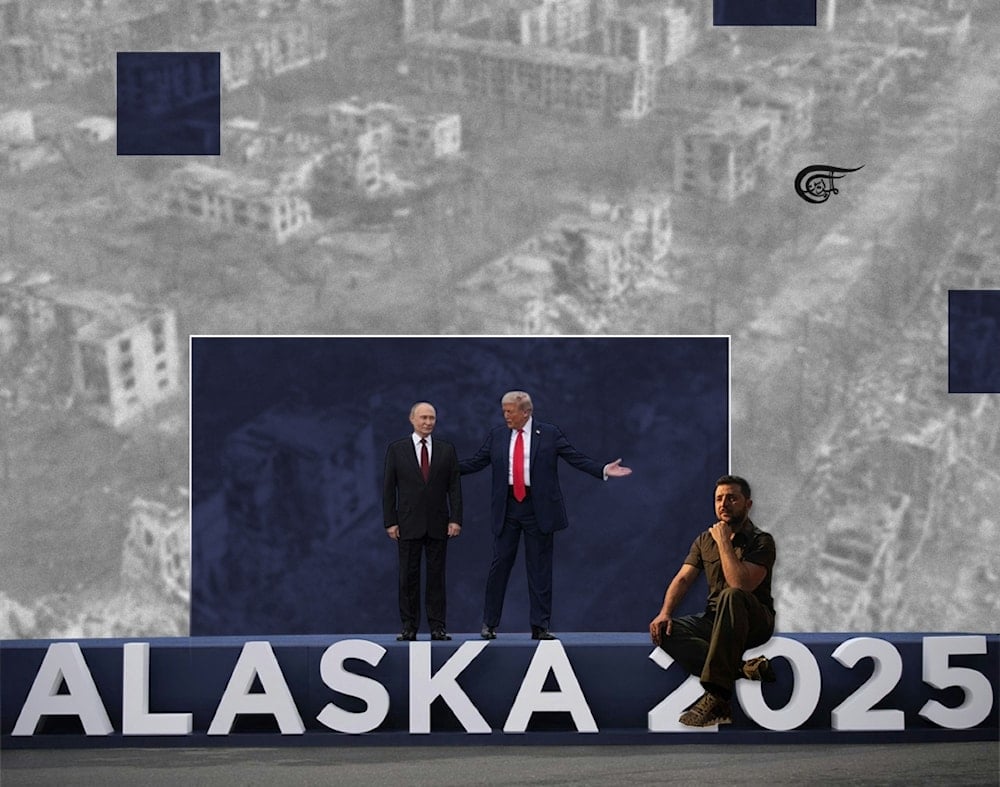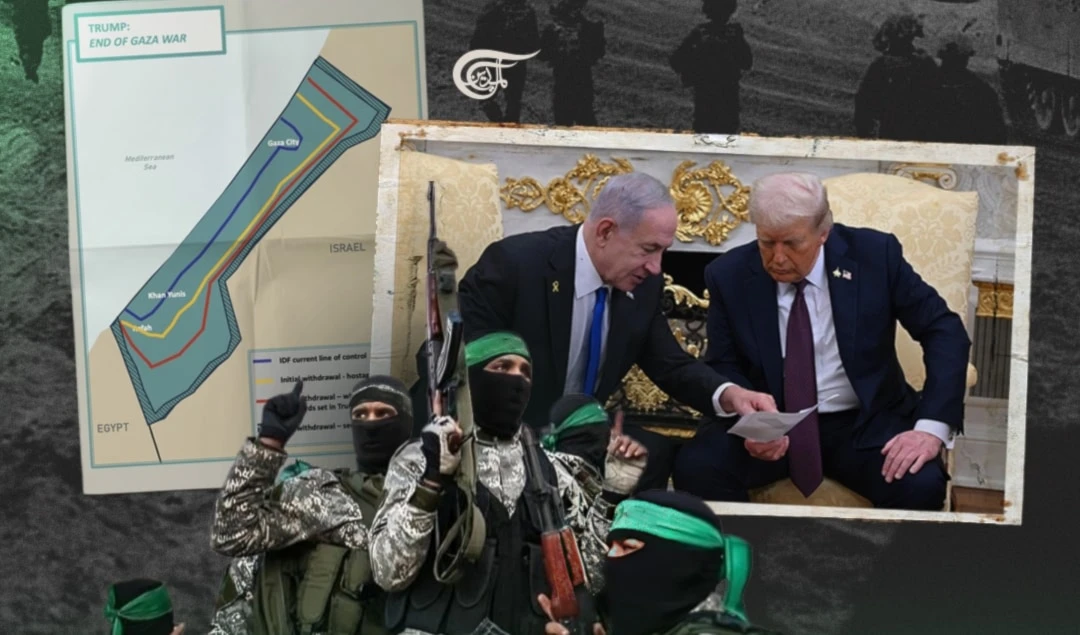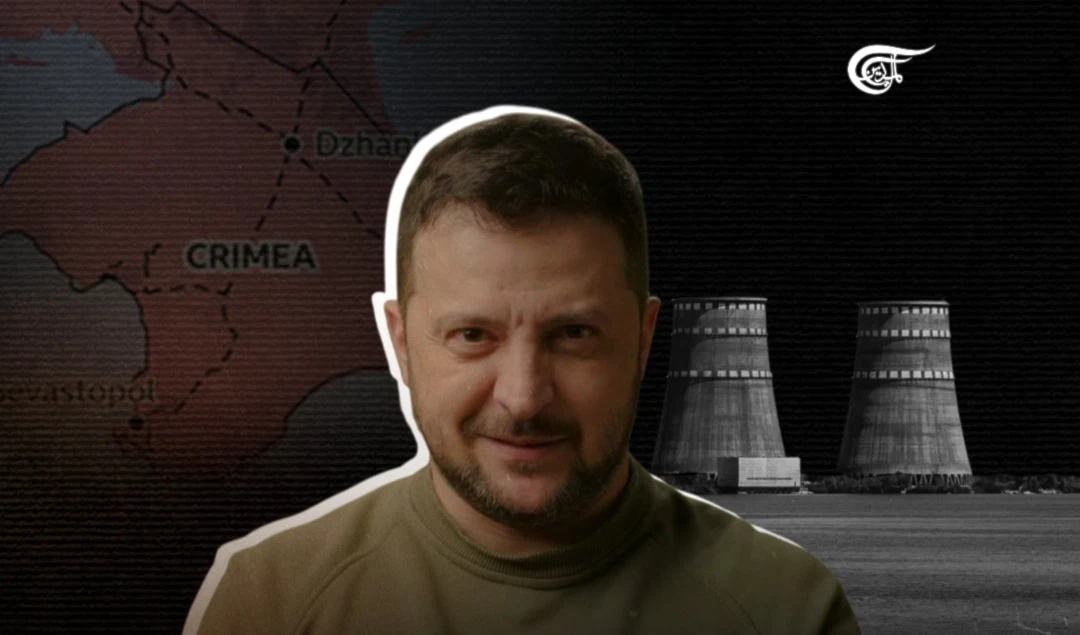After Alaska, Ukraine alliance envisions new war against Russia once current one ends
Dmitri Kovalevich reveals how Zelensky’s Washington visit exposed Ukraine’s role as a pawn, with its elites preparing for endless wars, even a “third war,” while society collapses under loss, desertion, and bankruptcy.
-

Among the results of the summit in Alaska is the fact that a precedent was set there for resolving the conflict without the participation of the Kiev authorities. (Al Mayadeen English; Illustrated by Batoul Chamas)
In the second half of August, Ukrainian society and media were focused on the August 15 talks in Alaska between the US and Russian presidents, as well as the talks in Washington three days later between the leaders of the Ukraine war alliance.
In Washington that day, the entire flock of warmaking European leaders joined Trump and Ukrainian President Volodymyr Zelensky in their role as support groups. Western media closely covered both meetings, providing its worn spin on events. The following report focuses on reactions in Ukraine to all that was said and witnessed during these tumultuous days.
Against this backdrop, many Ukrainians hold hopes for peace. But the pro-Zelensky media and the legislators of the Verkhovna Rada (Ukraine legislature) are now working to ‘extinguish’ any expectations for peace. They have declared that the war may well continue for a long time yet. Zelensky’s appearance in Washington, they say, was necessary in order to ‘flatter’ Trump and maintain Washington’s financial support and arms supplies. During his five-minute meeting with Trump, Zelensky thanked him 11 times and sounded for all the world like a wind-up toy.
Ukrainian legislator Anna Skorokhod, who was elected in 2019 (the last election to have taken place in Ukraine) as part of Zelensky’s party machine and then expelled from it shortly after, acknowledges that Kiev is just a "pawn in someone else's game", Politinavigator reported on its Telegram channel on August 13. The publication said Skorokhod is comparing the current Ukrainian leadership to a dog on a leash in a kennel, barking loudly to attract the owner's attention and be allowed into the master’s house.
She has called for an end to the war with Russia because, she says, Ukraine's cemeteries have long been overflowing. She is urging Ukrainians to decide what is most important to them: saving lives or vainly struggling to hang onto territories already lost or deeply scarred by war. She considers Zelensky and his regime to be the main obstacle to ending the war, and says that the US and Russian governments are discussing the possibility of his overthrow by the Ukrainian military. "A military coup is being discussed quite a lot, including among the entourages of the two presidents who met in Alaska. A transfer of temporary power to the military who will sign any peace agreements they can eke out is in the air," she says.
Skorokhod has recently claimed that some 400,000 members of the Ukraine armed forces have deserted since 2022, and that number continues to rise.
Political scientist and analyst Ruslan Bortnik believes that Ukraine's strategy is to wait out a potential deal between the US and Russia, avoiding any direct clash with Washington while quietly sabotaging the implementation of any compromises that would favor Russia, including any ceding of territory already won by the Russian army and where votes to secede from Ukraine and join Russia have already been taken (Crimea in 2014 and the two Donbass republics plus the ‘new territories’ of Russia in Kherson and Zaporozhye, in 2022). According to one version being circulated, Ukraine would cede Donbass to Russia and acknowledge the reality of the 2014 vote in Crimea in exchange for a Russian withdrawal from the areas it controls in the eastern border oblasts (‘provinces’) of Sumy and Kharkiv.
The Ukrainian Institute of Politics (UIP), led by the aforementioned Ruslan Bortnik, believes that much of the talks that took place in Alaska will not be made public but can be ascertained and judged by indirect signs, reports Politnavigator on August 13. In particular, the online publication notes that Washington’s plans will best be signaled by the continuation or the reduction of its arms supplies to Kiev. He says plans will also be revealed by US sanctions policy towards Russia's trading partners, primarily China and India.
Vague diplomatic statements about ‘peace’ are being issued by many Western leaders, but many political analysts in Ukraine actually expect an escalation of the military conflict. Washington’s attempt to reach a ‘peace’ agreement with Russia surrounding the meeting in Alaska is best understood as being motivated by an anticipated collapse of Kiev's military frontlines, while the hope that these lines might serve as a future border between Russia and Ukraine, give or take a few kilometers, or few dozen.
"If the outcome of the summit turns out to be negative, further escalation of the conflict awaits us. Neither a tripartite meeting [Trump-Putin-Zelensky] nor an extended negotiating format [to include leaders of the three, leading warmakers of the EU—Britain, France and Germany] will be announced. Instead, we will hear vague diplomatic statements without concrete steps while the USA continues supplying weapons to Ukraine and it implements previously planned sanctions pressure on Russia's trade allies."
"Strategically, Trump is now seeking to accelerate the negotiation process due to the deteriorating situation for Ukraine on the front lines. The Ukrainian army is steadily retreating, and although the country is far from military defeat, Kyiv is suffering significant territorial losses," writes the journal. "At the same time, sanctions pressure on the Russian Federation by the U.S. and Europe has failed."
The former advisor to Zelensky’s presidential office, Alexei Arestovich, argues that the war will grimly continue until a major military, political, and social catastrophe for Ukraine occurs. "And then it will become clear: if the Ukrainian elite and the common people have the wisdom to seek a new form of existence for Ukraine, with a change in its national project, then the county will stand a chance to survive and create a new future. But if they don't have enough sense, then others will set the future agenda here."
The Ukrainian Telegram channel Legitimny believes that everyone in Zelensky’s entourage is now prepared to hand over Donbass to Russia, but they are all concerned about personal guarantees for themselves in such a case. "Simply put, Zelensky and Yermak (the top advisor in Zelensky’s office) want guarantees that they will be allowed to continue ruling Ukraine. This is a matter of personal self-interest, as they both fear losing power, leading to the complete destruction of Zelensky's cult of personality and the dispossession of his entire elite of advisors."
Journalist Oleg Yasinsky, born in Ukraine but now living in Chile, notes that among the results of the summit in Alaska is the fact that a precedent was set there for resolving the conflict without the participation of the Kiev authorities, on whom nothing ultimately depends. Yasinsky is a harsh critic of the Russian government, but he considers Zelensky’s government illegitimate. He expects Zelensky to stage another bloody battlefield spectacle in the near future in order to once again "try and convince Trump that Putin is a monster with whom it is impossible to negotiate".
Yasinsky believes that too much was expected from the meeting in Alaska. It is unlikely to change the course of human history, but it may influence many processes as concerns Ukraine. In his opinion, Russia is currently playing an interesting diplomatic game: taking advantage of Trump's narcissism, it is driving Zelensky into a corner. "By meeting with the American president on his territory, Putin is putting Kiev in a position where any response on its part will be a failure.
"Trump is currently in a difficult and unstable domestic situation, while Russia is ready to help him create an image as a ‘peacemaker’," Yasinsky writes. He says Kiev has been completely sidelined for the first time since 2022, and any public outrage it expresses over Washington’s future moves will be considered by Trump as an affront. "Russian diplomacy is becoming similar to the work of a trainer in a zoo who is well acquainted with the behavioral characteristics and dangers of the animals in his care."
In this situation, the Zelensky administration's interests lie in publicly voicing desires for peace while dragging out any such process for as long as possible, regardless of any new losses of territories. Zelensky can only agree to a ceasefire in order to gain a respite while continuing to draw Western countries into the conflict, effectively risking a World War III between Russia and Ukraine’s Western allies. Last year, Zelensky signed security agreements with a number of Western countries that contain clauses allowing for a possible participation of Western armies in the event of a renewed conflict. Thus, only one day may pass between the end of one (the current) war and the beginning of another.
Zelensky is already talking about a ‘third war’ if Ukraine is forced to withdraw from Donbass. In today’s Ukrainian mythology, the ‘first war’ is considered to be the war against the Donbass republics from April 2014 to early 2022. Then a ‘second war’ began in February 2022 with Russia’s Special Military Operation. Now Zelensky is talking to his backers in the European Union, who have previously signed military agreements with him, about a ‘third war’ in which European troops become involved in the event of "new aggression" by Russia.’ Zelensky can easily arrange for this "new aggression" by using false flag operations to provoke it.
"Let me remind you," writes Ukrainian political scientist Mikhail Chaplyha on Telegram on August 12: "Any ‘security’ agreements will be signed by Kiev on condition that a third war will be commenced following an appropriate lapse of time."
Ukraine's new Defense Minister Denis Shmyhal (a former Prime Minister – ministers in Ukraine regularly swap places to demonstrate that ‘reforms’ are taking place) assures his audiences that even after theoretical peace agreements with Russia, Kiev does not intend to reduce its army. Its Western backers will be expected to continue to finance and arm Kiev and its army, since the bankrupt state has neither the funds nor future expected revenues to sustain a million-strong army.
"One hundred per cent of Ukraine's GDP is now devoted to debt repayment. This has never happened before. All economic indicators show that we are bankrupt," Ukrainian legislator Mikhail Tsymbalyuk admitted recently.
For Ukrainian society, maintaining the army will mean the continuation of ‘busification’ (forced conscription) and a dictatorship of field commanders, while Ukraine’s western and northern border crossings will continue to be closed to all Ukrainian men hoping the leave or escape from the country. Maintaining a large army for decades is too expensive, so much of it will need to be rebuilt anew.
The continuation of the present war or the sparking of a new, extraordinary war would be beneficial to the Ukrainian elite, allowing them to continue to pillage the sums pouring into the country from the West, sums they could not dream of acquiring in peacetime conditions.
Immediately after the meeting of Zelensky and European leaders with Trump in Washington on August 18, European leaders once again (probably for the tenth time in three years) began talking about sending their own countries’ troops to Ukraine.
The UK is saying it is ready to deploy 30,000 troops to Ukraine, but this is fantasy; this would represent more than 25 per cent of its current armed forces of 114,000. (No wonder the UK government is musing of re-introducing some form of compulsory military service; and good luck with that!). Germany claims flatly that it cannot afford to send troops to Ukraine. Lithuania and Estonia each say they are ready to provide about 100 soldiers each. Little wonder that these European leaders are counting on the Trump regime to ride to their rescue, hoping that the U.S. may take on the leading financial and military role for western imperialism as it did in Afghanistan in 2001 and Iraq in 2003 (with results only too well known).
The European armies said to be ready to ride to Ukraine’s rescue are not even sufficient to operate in two or three Ukrainian oblasts (provinces), let alone the 20 or so other ones fully or partly controlled by Kiev. The two Donbass republics of Donetsk and Lugansk voted in 2022 to secede from Ukraine and join the Russian Federation (though all of Donetsk is not yet liberated), as have done the two ‘new territories’ of Russia (Kherson and Zaporozhye). Crimea was an autonomous republic of Ukraine until it voted in 2010 to secede and join (rejoin) Russia.
"Behind the propaganda rhetoric about protecting Europe from a Russian offensive, solidarity with Ukraine, and so on lies banal, self-interest. Playing at warfare war with someone else (the West) helping to do the dirty work has turned out to be a profitable and extremely exciting national business," writes Pavel Kotov, a columnist for the news website Ukraina.ru.
Finnish President Alexander Stubb has stood out among European ‘hawks’ for demonstrating the racism of European political elites towards the peoples of the Russian Federation. He has recently called the Donbass cities of Kramatorsk and Slavyansk "bastions against the Huns", attempting to stir up medieval fears of ‘Asian invaders’. ‘Huns’ is a pejorative, historical term for the tribal warrior groups that occupied the steppe regions of western, Tsarist Russia, including today’s eastern Ukraine. Stubb is likely ignorant of the fact that it was in Kramatorsk and Slavyansk in April 2014 that the Donbass population began its uprising against the 2014 coup in Kiev and the neo-Nazi paramilitaries that served as the shock troops of the coup.
Stubb also demonstrated a complete ignorance of his country's own history. At a meeting with Trump on August 18, he said that Finland had found a "good solution" in 1944 to end its participation in World War Two, suggesting that a similar solution could be found to end the ‘aggressive Russian war’ of today. He is referring to the treaty that Finland was forced to accept with the Soviet Union in 1944 in which it managed to retain its independence despite its government’s support to Nazi Germany, including its participation in the genocide-like blockade of the city Leningrad from 1941 to 1944. The Finnish government of the day capitulated in 1944 and switched sides.
Under its 1944 surrender treaty with the Soviet Union, Finland ceded territory (including its access to the Arctic), paid reparations, changed its government and turned its weapons against its former Nazi German allies. It handed many Nazis over as war criminals to the judicial system of the Soviet Union. The treaty committed a new government in Finland to renounce participation in any future military blocs and renounce any future hostile moves in domestic and foreign policy directed against the USSR. (The Nazi-allied government of Finland called itself a ‘free ally’ of the Nazis, in contrast to the governments of Italy, Romania and Hungary which were directly allied by treaties.)
Russian commentators and politicians reacted, many mockingly, to Stubb's ignorant statements. Apparently, without realizing it, using Finnish history as his example, Stubb advocated a surrender of Ukraine to be followed by a treaty as a good model for today’s conflict in Ukraine. Such is the intellectual capacity of a typical western European leader today besotted with the ‘dream’ of war against Russia.

 Dmitri Kovalevich
Dmitri Kovalevich
 14 Min Read
14 Min Read











